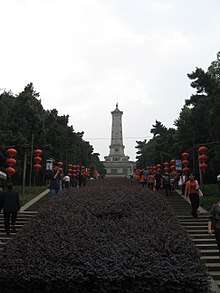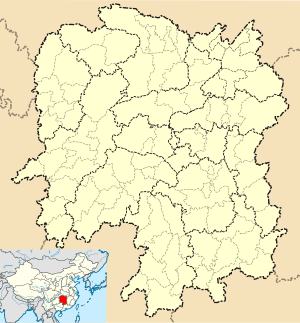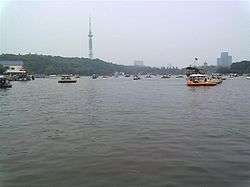Hunan Martyr's Park
| Hunan Martyr's Park | |
|---|---|
| 湖南烈士公园 | |
 The Martyr's Monument at Hunan Martyr's Park. | |
  | |
| Type | Natural Area |
| Location | Kaifu District, Changsha, Hunan |
| Coordinates | 28°12′52″N 112°59′59″E / 28.214581°N 112.999764°ECoordinates: 28°12′52″N 112°59′59″E / 28.214581°N 112.999764°E |
| Area | 343.3-acre (138.9 ha) |
| Created | 1953 |
| Founder | Changsha government |
| Operated by | Changsha government |
| Visitors | 10 million each year[1] |
| Website |
hnlsgy |
Hunan Martyr's Park (simplified Chinese: 湖南烈士公园; traditional Chinese: 湖南烈士公園; pinyin: Húnán Lièshì Gōngyuán) is an urban park and the largest park in Changsha, Hunan, China.[2] Covering an area of 343.3-acre (138.9 ha), the park was constructed and opened to the public in 1953. It is a renowned scenic spot integrating memory, leisure and tourism. Hunan Martyr's Park has been designated as a "Provincial Key Cultural Protection Unit" by the Hunan government and a "National Patriotic Education Base" by the Publicity Department of the Communist Party of China. In 2009 it was categorized as a "National Key Park" by the Ministry of Housing and Urban-Rural Development.[3][4]
History
Construction began in 1952 and completed in 1953, and opened to the public in May 1956. It covers an area of 343.3-acre (138.9 ha), of which land area of 171.985-acre (69.600 ha), and water area of 171.32-acre (69.33 ha). The Three-Arched Bridge (三拱桥) and Yingfeng Bridge (迎丰桥) were established in 1973 and 1982 respectively. In 1983, Hunan Martyr's Park was listed as a "Provincial Key Cultural Protection Unit" by the Hunan government. The Hunan Folk Culture Village (湖南民俗文化村) was constructed in 1992. Since May 2000 Hunan Martyr's Park open to visitors for free. It was restored in July 2007.
Climate
Hunan Martyr's Park enjoys a subtropical humid monsoon climate and exhibits four distinct seasons, with an average annual temperature of 17.21 ℃. Spring and fall are warm, while winter is chilly with cold wind. Winter temperatures average around 5 ℃. Summers are very hot and dry with a July daily average of 29 ℃.
Plant resources
There are more than 326 species of plants in the park, of which more than 150 thousand trees and 1.75 million flowering shrubs.
Parks
Hunan Martyr's Park is divided into six scenic areas, including the Martyr's Memorial (烈士纪念园), the People Leisure Park (百姓休闲园), the Water Scenery Park (水域风光园), the Folk Culture Village (民俗风情园), the Adventure Playground (儿童游乐园), and the Landscape Recreation Park (山水休闲园).
Tourist attractions
Martyr's Monument
The Martyr's Monument was built in 1959, it can be divided into upper and lower segments. The upper is a monument and the lower is a memorial hall. With the height of 58.7 metres (193 ft), it was made of 2,932 pieces of white marble and granite. A inscription which was written by Mao Zedong on the monument. It reads "The Monument of Hunan Martyr's Park" (湖南烈士公园纪念碑). There are over 90 martyrs’ portraits and the famous sayings collected from more than 100,000 Hunan martyrs in the memorial hall.[5][6]
Nianjia Lake

Nianjia Lake (Chinese: 年嘉湖; pinyin: Niánjiā Hú), is a man-made lake with an area of 115.2-acre (46.6 ha).[5][6]
Yingfeng Bridge

The Yingfeng Bridge (Chinese: 迎丰桥; pinyin: Yíngfēng Qiáo) across the coast and islands is that the imitation Song-dynasty-style (仿宋风格) built of wood and bricks, with more than 254.5 metres (835 ft) long.[5][6]
Mid-lake island
The Mid-lake islands (湖心岛), also known as "Xiaoyang Island" (Chinese: 宵阳岛; pinyin: Xiāoyáng Dǎo), was built in 1963 with four islands, occupying 4.94-acre (2.00 ha) of land area.[5][6]
The Ferry of Red Army
In July 1930, Peng Dehuai led the Red Three Regiments (红三军团) to attack Changsha in Huji Ferry (Chinese: 湖迹渡; pinyin: Hújì Dù) of Liuyang River. After the establishment of Hunan Martyr's Park, Huji Ferry was placed under the Hunan Martyr's Park management and renamed "The Ferry of Red Army" (红军渡).[5][6]
Transportation
- Take bus No. 111 to the South Gate of Hunan Martyr's Park Bus Stop (烈士公园南门)
References
- ↑ "Hunan Martyrs Park". enghunan.gov.cn. 2015.
- ↑ "Hunan Changsha Martyrs' Park". bamboocompass.com. 2015.
- ↑ 公园简介. Hunan Martyr's Park (in Chinese). 2015.
- ↑ 关于公布第三批国家重点公园的通知 建城[2009]276号 中华人民共和国住房和城乡建设部. yuanlin.com (in Chinese). 2009.
- 1 2 3 4 5 美丽的长沙 湖南烈士公园. CRL (in Chinese). 2005-07-25.
- 1 2 3 4 5 你知道烈士公园的恋爱圣地吗?边赏景还能拿大奖. ifeng (in Chinese). 2016-07-18.
External links
- (in Chinese) Official website
| Wikimedia Commons has media related to Hunan Martyr's Park. |